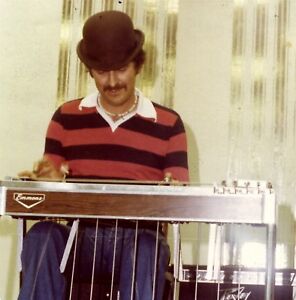

Swing was still big in Texas in the mid 1970s, so I had a chance to hear a lot of the greats like Bobby Black and Maurice Anderson. Later on, after moving to Austin, I started hearing some of the great swing players. I remember holing up for two years in a practice room at Beloit, playing five, six, eight hours a day, wearing the grooves out of records like 'The Ernest Tubb Story' and all those great Hank Williams LPs.

JE: Guys like Buddy Emmons, Bud Charleton, Lloyd Green, and Don Helms were big early influences. RB: Who do you consider to be some of your biggest influences? I attended Beloit College in Southern Wisconsin where I took several music classes and, incidentally, met fellow student Hank Seifert, brother of Ray Benson, leader of 'Asleep at the Wheel'. I pretty well burned myself out playing piano in grade school and high school, but this early exposure to harmony served me quite well later on. Both my parents are classical pianists, and they found me a great piano teacher who focused a lot on music theory. JE: I was raised in Grand Rapids, a small resort town in Northern Minnesota. RB: Tell me a little bit about where you come from, where you were raised, do you come from a musical family? etc. That is, if we take the time to go the next step.John and Robbie Bossert backstage at an Asleep at the Wheel concert in Pennsylvania, circa 1988. Whether it be TAB or written sheet music, the hidden GEM is they both reveal how the fret board or keyboard ( etc ) is laid out. Once we use TAB the next step should always be dissecting it to understand why it actually works on the fret board. Regarding TAB though, its a great tool to get started or to use as a reference,, keeping in mind that many of us are struggling to just become a "common player ". This is what separates the "common players" from the greats, the presentation of the music.

The way Buddy puts the lines together is a perfect example of his thought process, which is what makes the music so interesting. Yes, thx John, the lines are excellent examples of "single note pockets" which can be applied to massive amounts of music. Measure 2 and 3 are a sequence, one answering the other. You Emmons experts may know what pedals he used on this type of playing. The final measure starts with a backwards rake using the whole step interval between strings 4/5. It’s the same note played twice on different strings with a gliss. There is a false fingering toward the end which he used at a device to get to a lower position. I did not write much for the rhythms because it is a cadenza. He may have been thinking in fast triplets. It sounds like 16th notes to me, but his lines mostly fall in sequences of 6 notes. I don’t know if he used pedals, so I tabbed it for C6 without pedals, with parenthesis where he could have used pedals for half steps. I have written the notes and tabbed it for C6. Here is Buddy’s incredible cadenza at the end of Nightlife on the Austin City Limits video with Ray Price.


 0 kommentar(er)
0 kommentar(er)
